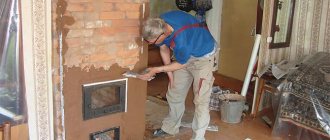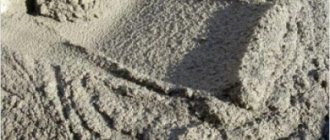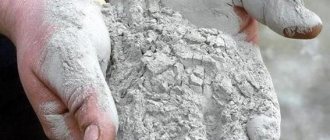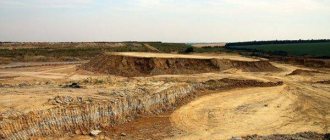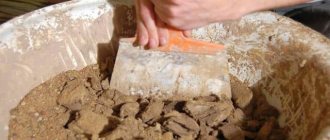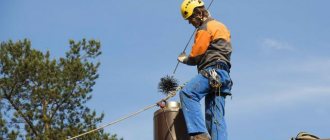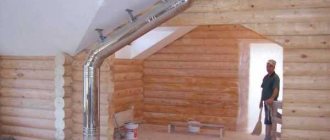Regardless of what type of mixture is used to lay the stove, it must be effective, because this means structural strength, good appearance, and safety during operation. There are several main compositions: clay, cement, lime. Each type of mortar is used at different stages of construction, so it is impossible to determine a universal option.
Absolutely all experts agree that bricks should be laid on clay.
Only this material has the necessary characteristics:
- When heated, the volumetric expansion of a normal mortar will coincide with that of a brick. This prevents the occurrence of cracks during operation.
- The material does not emit harmful substances at high temperatures.
- The strength when heated remains the same.
- The necessary adhesion between the bricks is ensured.
To prepare the correct mixture, you need to follow a number of steps.
What parameters are affected by the mixture for laying bricks?
A mixture of poor quality or inappropriate for operating conditions can cause very unpleasant consequences. The stove will either have to be constantly repaired, or completely redone taking into account the mistakes made.
The quality of the solution affects the safe operation of the furnace
How does a poor-quality masonry mixture manifest itself?
- Cracks in masonry joints. They are most quickly detected in places of maximum heating. The presence of cracks indicates that the strength of the furnace has decreased significantly.
- Smoke enters the room. A very dangerous phenomenon that requires immediate elimination. In winter, the stove is not dismantled; cracks have to be periodically sealed with mortar throughout the season. After a few days it falls out and the process needs to be repeated.
- The bricks are shaking. Such consequences are found near the firebox doors. Heavy cast iron structures are connected to bricks. If they are not strong enough, then the doors will wobble a lot when opening/closing. With such a problem, you can hold on to the heat, but you need to use the firebox very carefully and carefully.
If you use a low-quality solution, you will subsequently have to repair cracks in the slab
Plastering with clay and cement. Flaws.
In general, any properties can be called neutral. Under certain conditions they can become advantages or disadvantages.
- Moisture capacity. Saturation with water molecules changes the structure of the clay. This entails a change in its technical characteristics:
- Strength and hardness are reduced;
- Swelling leads to an increase in volume and mass;
- Soaking violates the integrity of the formation, which changes its geometric configuration - it becomes deformed;
- Shrinkage is a consequence of swelling. The clay is so plastic that it shrinks gradually and does not break. However, sudden drying can cause destruction (cracks, craquelure). Clay mortar for plastering walls is used with filler, which increases the strength of the layer.
- Thermal conductivity. For comparison: cement-sand plaster – 1.2 (W/m2K), cement – 0.93, lime plaster – 0.698, gypsum – 0.3. Clay – 0.7-0.9. A little “warmer” than cement. However, this property is used when finishing heating panels - the better the plaster conducts heat, the higher the heat transfer of the stove.
Recommended mixtures for laying a stove
The list does not include compositions with cement and gypsum. Now you understand that this is the worst option.
Table. Types of masonry mixtures for brick ovens
| Type of mixture | Brief description of physical and operational characteristics |
| Ready-made formulations | Modern mixtures include fireclay clay powder, sand and plasticizers. They are sold in bags, are easy to prepare, and perform their tasks very effectively. The only drawback is the relatively high cost. But stoves do not require a lot of mixture; the price of the solution does not have a noticeable impact on the cost of the facility. |
| They do it themselves. The master must have extensive practical experience to correctly select clay and sand, determine the optimal formulation, etc. This is a traditional solution, if the recommendations are followed, it fully meets the existing requirements of government regulations. As for the performance characteristics, they satisfy users in all respects. |
As an example, we will consider the process of preparing a mixture from ordinary clay.
Types of ready-made mixtures for laying stoves
Prices for fireproof mortar for stoves and fireplaces
Fireproof mortar for stoves and fireplaces
How to mix clay mortar?
The proportional composition of the binder components determines the purpose of the mixture: masonry or finishing. They may consist not of one binder, but of two, for example, clay and cement. The filler imparts rigidity to the hardened mixture, and a slight excess of it does not harm the quality of the masonry. Even a small excess of binder (in this case, clay) reduces the strength. That is why it is believed: the less it is in the solution, the higher its quality. However, it is better not to replace it with cement and lime; this is done only in cases where there is no clay.
The consistency of the mixture should be quite plastic, viscous, but not liquid, and even more so, it should not crumble. The furnace body should not have thick masonry joints, the optimal thickness is 3-4 mm. The sand grain should not exceed 1 mm. However, it is also possible to use coarser sand, but then its quantity will change.
The exact proportions depend on the quality of the clay:
- skinny requires reducing the volume of sand,
- oily is diluted in a ratio of 1:2 (clay:sand).
So, the proportions for fine sand and high-quality clay are 1:1. Mixing various additives will lead to their change towards reduction.
Practical tips for using the mixture
If you violate the generally accepted rules for laying stoves, then even with very high-quality mixtures you can get an outright defect. What do the professionals advise?
The quality of the furnace masonry depends not only on the mortar
- The clay should only be mixed with a special mixer; you can never achieve a homogeneous composition manually.
- The solution can be left for an unlimited amount of time. After drying, water is added and the composition is mixed. This cannot be done with cement-based solutions; once they harden, they cannot be corrected.
- Work is allowed only at temperatures not lower than +10°C. The bricks must be dry; the rate of moisture absorption does not affect the strength parameters.
- The first time the stove can be lightly heated no earlier than three days after the completion of the masonry. It is strictly not recommended to rush; if the recommendations are not followed, large cracks may appear through which smoke enters the room.
- To lay the outer row of the outer chimney, cement should be added to the mixture. Ordinary clay with sand is afraid of moisture and gradually erodes outdoors. Cement mortar does not react to the negative effects of natural precipitation.
For laying the chimney, use a solution containing cement.
Efflorescence may appear on poor-quality seams after the first fire, and white marks may be visible on the surface. This is a very unpleasant phenomenon and is removed over a long period of time. The efflorescence should be carefully scraped off, and then the surface should be trimmed with a damp cloth. Such actions will have to be repeated until the salts are completely eliminated.
How to remove efflorescence from the stove
The work of a stove maker requires not only theoretical and practical knowledge, but also great responsibility. This is one of the few construction works where no assistants are involved; all operations are performed by the master personally and bears full responsibility for the results of his work. Even a slight deviation from the recommended technologies becomes the cause of defects; to eliminate them, you need to lose a lot of time and financial resources.
Removing Impurities
Since the furnace solution necessarily contains sand, it must be thoroughly cleaned. First, river sand is sifted through a sieve with 1.5 mm mesh and then washed. To wash the sand, use a holder with a piece of burlap stretched over it with a slight sag. Sand is poured into it, the device is fixed on a stand and the mixture begins to be washed with streams of water from a hose. Continue washing until clean water flows from below.
The clay used in the mortar for laying the furnace must also be cleared of additional inclusions. To do this, it also needs to be washed. First, the rock is crushed and laid out in the upper part of a long vessel - a bathtub or trough. The containers are given a slope of 4-8º. Water is poured at the bottom of the vessel so that it does not come into contact with the clay. Using a scoop or shovel, they begin to carefully wash the clay rock. As a result, as the clay softens, a paste-like mixture is formed in the lower part of the container, which is placed in another container. Flushing continues until sufficient material has been collected.
To prepare a solution for laying a stove from dry packaged clay, it must be soaked. To give the material the required consistency, the dry mixture is poured into a container 10-20 cm high, and then filled with water to completely cover the clay. After 24 hours, the composition is mixed, if necessary, more water is added and left in this state for another day. As soon as the entire mixture turns into a paste-like mass, you can start working - the clay is ready. In this way, a sufficient volume of material is obtained.
Material requirements:
1. Water - must be completely clean, no moldy odors, and, importantly, it must contain a minimum amount of mineral salts. If you have problems with clean water, the column does not work, or well water contains a lot of dirt, take care of the water supply in advance. The calculation is simple: on average, laying 100 bricks will require a little more than one and a half buckets of water. (15-20 liters).
2. Sand - you need to work only with fine sand, which must be carefully sifted. For this we need a sieve. It is convenient to sift fine and clean sand through a fine-mesh sieve (one and a half millimeters).
3. The main component is clay. First of all, we are interested in its adhesive properties and its fat content. The amount of sand that we will add to the solution will depend on this; we will consider this in detail in the next paragraph.
Lime composition
Lime and gypsum mortar
When constructing stoves, more complex solutions using lime are also allowed. They are used mainly for plastering.
First of all, the lime is slaked with water and kept in a special container or pit for about 7 days. The result is “milk”.
There are several options for the mixture for preparing the solution:
- Clay plus asbestos. Proportions: 1 part clay, one lime paste, 2 sand and 0.1 asbestos. First, a dry mixture is prepared, to which thick “milk” is added from clay and lime, mixed in a separate container. After this, the solution is thoroughly mixed.
- Plaster with asbestos. Proportions: sand one, gypsum one, lime - 2 parts, asbestos 0.2. Preparation technology: dry ingredients are mixed without water and lime is poured in. After this, the finished composition is brought to a homogeneous mass and applied to the surface.
There is a limitation for such a solution - it must be used within 7 minutes. The culprit is gypsum, it hardens very quickly.
How to clean clay from sand at home - how to separate
Both materials belong to sedimentary rocks, but their properties are literally opposite. Sand absorbs moisture - up to 10%, but does not change its physical characteristics and does not form true solutions or suspensions with water. It serves as a filler for the building mixture and provides it with density and structure. Read about the density of construction sand.
After drying, the clay object becomes waterproof and does not change configuration. Clay acts as a connecting link.
Clay swells in water, increasing in volume and acquiring another property - plasticity. It can be given any shape.
A variety of compositions are used for bricklaying. The most famous is cement - a mixture of cement and sand. It hardens in conditions of high humidity, which makes it indispensable for the construction of buildings made of brick or stone. Clay-gypsum has different properties: gypsum reproduces complex and subtle shapes, but is afraid of moisture. Gypsum plaster is used to finish walls only in dry residential areas. This material will tell you about the dry universal mixture M 150.
A stove is a special structure. The bricks and the mortar connecting them are subject to heavy load: in the firebox the temperature reaches 950–1000 C, and in the upper part of the chimney it is only 50 C. The materials must withstand such changes, so they are selected carefully. Read about clay mortar for laying brick stoves here.
For the walls of the furnace, a composition based on red clay is used. For the combustion chamber and chimney you need a fireproof fireclay composition made from fireclay sand and clay.
| Options | river sand | Fireclay clay | Red |
| Specific gravity, kg, cubic m | 1,5 | 1,6–1,9 | Not determined |
| Grain size, mm | From 0.16 to 2 | 2 | From 2 to 5 |
| Mineral composition | Silica | Quartz, kaolins | Kaolinite, illite, other minerals |
| Impurity content, % | 0,7–1 | Up to 1 | From 5 to 9 |
| Plasticity number | – | – | 0,1–0,27 |
| Melting point, C | 1700–1800 | 1550–1580 | 1100 |
Compound
Clay acts as a binder in mortar. Its main property is plasticity, determined by such an indicator as the plasticity number or fat content. This is a changeable parameter. The composition of the mixture depends on what material is used.
- The fat content of a clay mixture can be assessed without special measuring instruments. A handful of the composition is moistened and kneaded. If the material acquires the consistency and elasticity of plasticine, the clay is fatty. If the lump crumbles, it’s skinny.
- A more accurate method is this: add 100–150 ml of water to 500 ml of clay, stir until smooth so that the material does not stick to the skin. Roll the mixture into 2 balls 50 mm in size and one is flattened into a flat cake. The samples are left to air dry for 2–3 days.
If cracks appear on the test lumps after drying, the clay is oily, it is mixed with a large amount of sand. If a ball thrown from a height of 1 m breaks into pieces, it is too skinny. It is mixed with fattier varieties.
The proportions of the oven mixture are determined by the plasticity number: for 1 part of clay take from 2 to 5 parts of sand. Depending on the fat content of the material, the masonry solution is prepared as follows: add 2 to 5 parts of clean river sand to 1 part of clay.
The quality of the mixture is constantly checked as it is produced:
- When kneading, the ingredients quickly form a homogeneous mass, since both components are capable of absorbing moisture. But if, after standing for half an hour, the composition separates - the clay is thin, swells little and contains a lot of sand.
- Delamination is also caused by excess water. It is simply drained. Another test: remove a layer of mass with a trowel. If the surface is cracked or torn, there is too little water.
- If the mixture has the desired consistency, but sticks to the shovel or to your hands, the clay used is too oily, you need to add river sand.
- Before constructing the furnace, a test laying of 2-3 bricks is performed. If the seams between the stones are not filled completely, the composition is too thin. It is enriched with the addition of a fatty variety.
Heat capacity of the mixture
The furnace structure is built from clay brick, since it can accumulate heat and release it slowly. The solution must have the same properties.
This parameter is very important, since the task of the furnace is uniform and long-term heat transfer.
Before making a solution from loam, the components for it need to be prepared - cleaned. They do this in 2 ways:
- Dry cleaning - select twigs, debris, leaves from the material. Then it is crushed and filtered through a sieve with a cell diameter of up to 2.5 mm.
- Wet - the clay is not free-flowing, so they often do it differently: they soak the material, and when it swells, rub it through large cells - up to 3 mm.
Wet cleaning method.
Features of operation
Before you start using the equipment, the internal formwork must be set on fire - otherwise it will not be accessible. This operation should be carried out extremely carefully so that the structure does not collapse and cracks do not appear. If cracks cannot be avoided, they are covered with a clay solution, but they must be widened before filling. Only after completing all the steps in the stove can you light a fire.
Before you start baking baked goods or similar foods, you must thoroughly heat the oven for 2 hours using dry wood. As soon as the firebrands appear, they are removed with a poker. The oven closes tightly. You will need to wait 15 minutes. During this time, the temperature inside will even out, and the bread will be baked well on all sides.
To determine the degree of readiness of the oven, you need to use a splinter - it is placed inside the oven for a few minutes, and then carefully examined. If it is charred, then you need to give the oven more time to cool, and if it has changed color - it has become browner, then you can start cooking. This will mean that the temperature has reached approximately 200 degrees. The baking technology is quite simple - you need to make sure that the dough is well baked.

